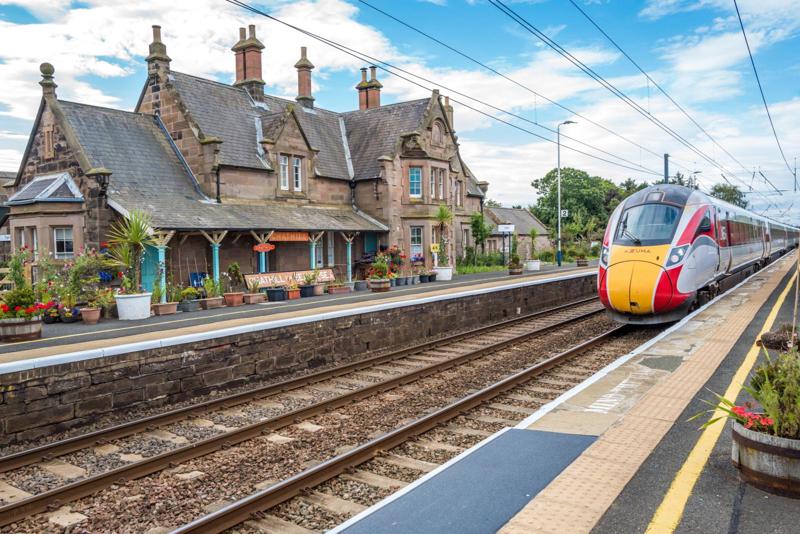Richard Foster explores a quiet area of the North East with one of the network’s quirkiest stations.
In this article:
- Chathill station, a remote and historic stop in Northumberland, survives despite limited use and idiosyncratic quirks.
- The station's existence owes much to local factors, such as its past as a postal hub and proximity to landmarks.
- Proposals to boost regional rail, including reopening nearby stations, aim to unlock Northumberland's untapped tourism potential.

You could imagine timetable planners at Northern waking up in a cold sweat thinking about Chathill.
Chat - where?
Chathill is a station on the East Coast Main Line between Alnmouth and Berwick-upon-Tweed. In fact, it’s the only station between Alnmouth and Berwick. After Berwick, it’s England’s second most northerly station.
It’s easy to see why it causes timetable planners such a headache. The 60-or-so miles of ECML between Newcastle and Berwick is largely double-track all the way, with few refuge loops. LNER, CrossCountry, TransPennine Express and Lumo all require access, as do goods workings… and charters.
Somewhere in between that lot, planners also have to include a Northern ‘stopper’ which serves the seven intermediate stations between Newcastle and Chathill - all for the benefit of a handful of people.
Chathill is a wonderfully idiosyncratic station. You can’t, for example, catch a train north from its two platforms.
By rights, it shouldn’t have survived. At the 1923 Grouping, there were 12 stations between Alnmouth and Berwick. There had been more. Lesbury was the shortest-lived, closing in 1850 after just three years’ use. Smeafield and the former private station at Falloden closed in the 1930s, followed by Newham in 1950 and Scremerston in 1951.
When the Transport Users’ Consultative Committee met on June 23 1966, there were just three left (although Tweedmouth was still retained for goods traffic).
Up for discussion was the closure of Beal and Belford stations, along with Alnwick, terminus of the short branch line from Alnmouth.
Chathill was not on the list, to the incredulity of locals. Belford, attendees said, was a much bigger settlement (it had 891 inhabitants compared with Chathill’s 50). Belford was also closer to the coast, closer to Bamburgh and Seahouses.
One objector claimed that the infrastructure at Chathill was not suitable for its new role as the area’s main railhead. BR responded by saying that its oil lighting was sufficient.
BR also proved that Chathill was twice as busy as Belford - 30 people used it a day, whereas only 14 used Belford.
The TUCC sent its report to the Minister of Transport, and Barbara Castle duly responded on January 2 1967 by saying that Alnwick, Beal and Belford stations would indeed close. By the end of January 1968, they were gone.
Chathill issued 2,373 tickets in 1967. In 2022-23, that had dropped to 1,348. There are now, on average, fewer than five people waiting to use its only morning train.
Gair Unwin knows them all by name.
By day, Unwin works for Northern in its ticket office at Alnmouth station. But at the end of the day, he retires to Chathill’s station house, which he’s called home for the past 26 years. There’s nowhere else he’d rather be.
Unwin is also mystified by the decision to retain Chathill. He suspects that its survival was down to the location of the Post Office opposite the station. This acted as the main sorting office for the local area and received a lot of mail and parcels traffic by rail.
Unwin hails from County Durham, and Seahouses and Bamburgh became a regular holiday haunt when he was younger.
“We were probably one of the first tourists to come here by car,” he says.
Regularly getting stuck at Chathill’s barriers must have made an impression, because it’s led to a lifelong love affair with the place.
“I was working in Edinburgh at the time, living in a caravan in Lucker. I saw the station building was for sale, so I bought it.”
The station buildings had been converted into offices. The gardens were full of weeds. Unwin started to undo the years of neglect. As well as converting the building into a home, he externally repainted it into North Eastern Region light grey and blue with tangerine ‘hotdog’ totems. He’s also collected other signs and ephemera to enhance the railway feel.
The platforms are bursting in colour in summer thanks to the myriad pots, which (he estimates) consume some 80 gallons of water a time! Unwin simply treats the platforms as his garden.
Chathill station was built by the Newcastle & Berwick Railway. The scheme was part of George ‘the Railway King’ Hudson’s plan to link York with Edinburgh. The Newcastle & Berwick Railway Act was passed on July 31 1845. It had taken over the Newcastle & North Shields Railway the previous year, and the new line to Berwick diverged from a junction at Heaton.
Trains started running between Heaton Junction and Morpeth on March 1 1847. On March 29, the line between Tweedmouth (on the southern side of the Tweed Valley) and Chathill opened.
The link between Chathill and Morpeth was not filled by rails until July 1 1847. That year, the Newcastle & Berwick merged with the York & Newcastle Railway to form the York, Newcastle & Berwick Railway (YN&BR).
Tweedmouth remained the northern terminus until the summer of 1850, when the Tweed Valley was bridged and YN&BR trains could reach Berwick. Hudson’s dream was realised, but it was the North British Railway that provided the Edinburgh-Berwick link to his scheme.
Chathill now settled down to life as an intermediate station. Only its owners changed - the YN&BR merged with the Leeds Northern Railway and the York & North Midland Railway in 1854 to form the North Eastern Railway (NER).
One of the ‘stars’ of Unwin’s collection is an original running-in board that proclaims “Chathill for Seahouses”. That’s because Chathill hasn’t always been this isolated wayside anachronism.
The Pier & Harbour Order Confirmation Act had enabled Lord Crewe’s Trustees to build a new harbour at Seahouses - a small fishing village on the southern edge of the Bamburgh estate (Lord Crewe had acquired the estate by marriage in the 18th century).
As part of the development, the Trustees approached the NER with a view to building a connecting branch line to the new harbour (completed in 1888). The NER declined, and so the Trustees built the line themselves.
Its Bill was signed in 1892, but it took until August 1 1898 before the four-mile line from Seahouses to Chathill opened for goods (passenger traffic started on December 18 that year).
The delay had been caused by the inability to raise money - and that was despite the subsequent savings made possible by applying for a then-new Light Railway Order. Sir William Armstrong (of W.G. Armstrong/Armstrong-Whitworth fame, and from 1894 the new owner of Bamburgh Castle) even made an investment.
North Sunderland was the only intermediate station. Neighbouring Seahouses, the ‘Sunderland’ part of the name (according to historian Alan Wright) was a corruption of ‘southern lands’ - ie, the southernmost part of the Bamburgh estate. The ‘North’ prefix was added to avoid confusion with the city on the mouth of the river Wear.
The North Sunderland Railway was an early user of diesel traction. It acquired Armstrong Whitworth 0-4-0DE The Lady Armstrong on a hire purchase agreement from its maker in 1934.
But the line always struggled to make money, and it was perhaps no surprise when the ‘Farne Islander’ (as the last train was named) ran on October 27 1951. And while the locomotive (68089) had ‘British Railways’ on its tank sides, the line remained completely independent - the ‘Y7’ 0-4-0T had been hired from its nationalised neighbour.
There are plenty of railways where you might think: ‘if only it hadn’t closed’. The North Sunderland Railway is definitely one of those.
The whole Northumberland coast, from Lindisfarne down to Alnmouth, is a tourist hotspot, its rich history complemented by miles of beautiful sandy beaches. Bamburgh is arguably the biggest draw. Northumberland County Council proudly announced in July that it had been voted Britain’s favourite seaside destination - for the fourth year running.
It’s somewhat ironic that a car park has been built on the site of Seahouses station, and is frequently full to bursting at peak season. If only the North Sunderland Railway had remained open, a Newcastle-Seahouses service might be very popular during the summer months.
“There are lots more visitors in the area now,” says Unwin.
He explains that as well as the typical tourist attractions, new businesses such as wedding venues are popping up. But the effects of COVID on train travel could be felt in this corner of Northumberland, too, as people chose to work from home rather than commute.
The major problem is that Chathill is still four miles away from the major tourist hotspots. That was not such an issue in times when more people were prepared to walk, but it won’t help take tourists away from the convenience of their car.
You have to be a hardy soul to travel to Chathill by train. At the time of writing, Northern’s morning services leaves Newcastle at 0557 and arrives at Chathill at 0648. It runs empty as far as Belford, where it crosses over to the Up line. The service then departs Chathill at 0708.
The afternoon service leaves Metrocentre (to the west of Newcastle, on the south bank of the Tyne) at 1740, arriving at Chathill at 1856. This crosses over at Chathill Junction - this forms the 1915 departure for Metrocentre.
This pattern runs Monday to Saturday. There is no service on a Sunday.
Northern has made somne tweaks to improve the service. “It used to get looped at Morpeth,” says Unwin.
But is there any point doing any more? Unwin’s not sure, especially as “it’s ten minutes down the A1 to Alnmouth station”.
Here, passengers can join LNER, CrossCountry and TransPennine Express (as well as Northern) services to reach other parts of the country.
Northumberland is not devoid of railway investment. The multi-million-pound Northumberland Line opened in December 2024, with more stations along the line opening in 2025.
But these are the large, more-urban communities to the south of the county. What of the more rural settlements to the north?
South East Northumberland Rail User Group (SENRUG) campaigns for improvements to be made between Morpeth and Berwick. It has proposed reopening Beal and Belford stations, to provide access to Lindisfarne and Bamburgh respectively, as well as new timetables and for the whole line to be re-branded the ‘Northumberland Coast Line’.
SENRUG’s website notes: “Cornwall enjoys a good local public transport network and has a strong tourism industry. Norfolk enjoys a reasonable public transport network and has a reasonably developed tourism industry. Whereas north Northumberland has a poor public transport network and has under-exploited tourism potential.
“ line runs parallel to the coast overlooking glorious sea views, yet no local trains run over it. It would connect various locations on the Northumberland Coast Path and Cycle Path, and serve St Cuthbert’s Way (a long-distance path) at both Belford and Beal. Good public transport links would make north Northumberland a more attractive holiday destination and increase inward investment.”
There are some green shoots of optimism, however.
Earlier this year, the North East Joint Transport Committee (NETJC) published its North East Rail & Metro Strategy earlier this year.
NEJTC is backed by the likes of the North East Combined Authority, Nexus, and Transport North East. And this document - as its name suggests - outlines the North East’s rail strategy through to 2035.
Scheme NO13, included in the 2022-28 Delivery Plan and promoted by Northumberland County Council (seconded by Network Rail), is the reopening of Belford station.
It closed in 1968, but the main station building still survives (as does the remains of its signal box and a mothballed spur into an abandoned quarry).
The town itself is home to fewer than 2,000 inhabitants, but it’s one of the largest settlements close to the East Coast Main Line in the area. It’s bursting with history, once being a regular stop for changing horses on the Great North Road.
Sister scheme NO14 - again promoted by Northumberland County Council and backed by Network Rail - proposes a new hourly service between Newcastle and Berwick. Again, this is included in the 2022-28 Delivery Plan.
Whether these schemes are ever implemented remains to be seen. For the moment, Chathill is likely to remain the quiet place it has been for decades, where Unwin hears “more sound from the level crossing than the trains”.
Bamburgh, Lindisfarne, Alnwick - these are ‘must see’ places for any visitor to Northumberland. But why not take a few minutes to rest in the peace of Gair Unwin’s ‘garden’, take in Grade 2 Listed buildings steeped in history, and simply marvel at what a quirky station this is?
You’ll probably have the place to yourself.
For a full version of this article with more images, Subscribe today and never miss an issue of RAIL. With a Print + Digital subscription, you’ll get each issue delivered to your door for FREE (UK only). Plus, enjoy an exclusive monthly e-newsletter from the Editor, rewards, discounts and prizes, AND full access to the latest and previous issues via the app.














Login to comment
Comments
No comments have been made yet.